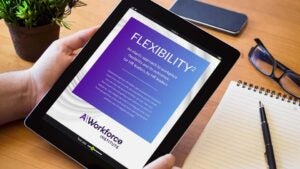What’s working with workplace flexibility: for HR leaders by HR leaders
Workforce science reveals new best practices for employee flexibility
e-books
Updated on March 20, 2023

Topics Covered:
Future of work
If you’re wondering how other organisations are faring with flexibility, look no further than Flexibility2, an e-book brought to you by the Achievers Workforce Institute’s LAB: its Leadership Advisory Board.

In Flexibility2, these global HR leaders and consultants in employee experience, total rewards, and operations provide a birds-eye view into the state of flexibility at work. Peer into their experiences navigating organisations in a variety of industries. Gain insight into what’s working and what’s not from the perspectives of the individual, team, and organization – and how you can ensure that your strategies can align. Here are the top takeaways from each chapter.
Re-thinking workplace policies – or doing without them altogether
Some organisations that have had flexible work policies in place for many years, and which not everyone seemed to follow, will know that non-compliance is not a new issue. It is one that has new context after several years of most online workers working from their home office. Employee input may have guided new policy, but compliance is still a problem when what employees say they’ll do doesn’t consistently reflect what they actually do.
The common denominator among solutions for employees returning to the office was that the mindset that simply “going back to the office” was just not working. What it all comes down to is that employees want what they have always wanted: to be masters of their lives and to be trusted to get work done in a way that works for them as human beings. Employees want flexibility. We’re all adults; employees want to be in control of day-to-day decisions about when appointments are scheduled and who they spend their time with. If working from home on a Friday is natural for people, and makes them happy, giving that to them is a win on engagement.
The very bottom line is that it doesn’t matter what days, hours, or schedules people have – what matters is their engagement with the organization. If employees are empowered to choose how they work best, they’ll want to give back to the business. After all, employees and leadership are partners and invested in success. When people feel heard and appreciated, the business benefits.
What about the offline workforce?
Not all roles are created equally flexible. Granted, flexibility for offline employees is difficult; there’s a big difference in the lived experience of “online” employees and “offline” employees. However essential offline employees may be, they have often been left out when there were celebrations of office workers coming back. With clocking in meaning no flexible work-from-home options, organisations and their leaders had to discover, on the fly, other ways to introduce flexibility into the employee experience for offline workers: What would be the options for those who couldn’t work from home?
When building flexible programs for offline work, many leaders leaned toward their knowledge of what online workers said they wanted in flexibility: agency and autonomy – so that everyone had the same opportunity in decision-making around how they meet expectations of their managers. Flexible days and hours and predictable time off helped get closer to policies that reflected lived actions and experience as organisations have been learning about the importance of proper expectation setting. After all, employees need clear expectations and boundaries with flexibility built into them.
6 actions for achieving desired outcomes of flexibility at work
1. Define and redefine
Expanding the definition of flexibility beyond where and when work gets done means expanding how we think about flexibility beyond work/life balance – beyond hours and workplace to how and where to offer flexibility. Work with employees to define greater work flexibility and productivity alike, outline benefits and outcomes, clarify expectations, and include examples.
2. Include everyone
When building flexibility into the workplace, inclusion means levelling the playing field as opposed to a setup where it’s remote vs everyone in the room. Set up environments where all employees are included, based on individual flexibility. Eliminate situations that can result in sidebar conversations among those who are physically in the room that remote employees can’t hear, for example.
3. Ask, answer, act
Gathering and acting on feedback drives strong business outcomes with three times more engagement, belonging, trust, commitment, and virtually anything else on the HR agenda. Put good listening mechanisms in place and be on top of the pulse of the people. Do continuous surveying as an important part of the conversation and follow up on conversations. Do say, “Now we will do a,b,c to address x,y,z.”
4. Train at all levels
Organisations haven’t yet officially trained on how to lead differently in the new, flexible environment. People need to know what to do and how to lead, from mid-level managers and new managers to executives. Training must start with executives and the shift of their perspectives from the old way of doing things to new paradigms. Determine how to upskill junior and senior employees so they can lead and manage in a flexible work world.
5. Be accountable and expect accountability
Policies must be justified as employees push back on return-to-office requirements. The generational shift has been from having a policy because organisations say so to a desire for transparency and accountability. Foster commitment with boundaries and be consistent with flexibility and put a stake in ground. Hold leadership accountable and ensure everyone is clear on principles and policies, and that everyone is on board.
6. Recognise the right behaviours
Recognition is critical to building high-performing flexible workplaces and is meaningful when it’s specifically about the behaviour: the personalised details, and the impact of the behaviour being recognised. Ensure the organisation is recognising and rewarding behaviour in a way that is consistent with company values. Tracking and monitoring is a helpful indicator of a recognition program, but to demonstrate sustained impact to the business it’s necessary to capture and measure outcome metrics beyond the program, such as engagement and retention, so recognition can empower all engagement drivers.